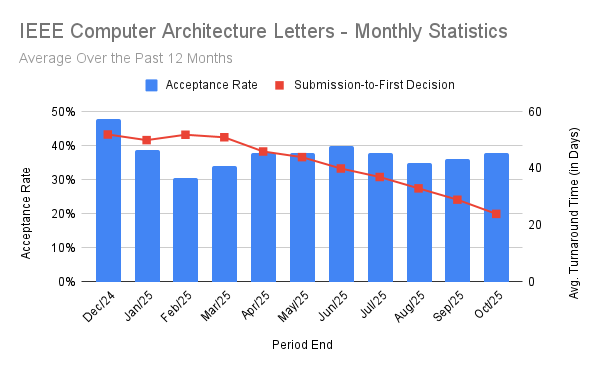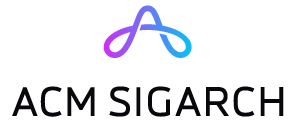CAL has held a unique place in the computer architecture community for well over two decades as a periodical for publishing early and exciting results. CAL papers are only four pages long and undergo rigorous peer review to select those with novel ideas and/or insights that are of interest to the computer architecture community and may have high impact. Another unique attribute of CAL is that it has historically provided a shorter turnaround for reviews compared to conferences and journals. As you will see below, the turnaround time to the first decision is now typically about 30 days
We began our EIC/AEIC terms on January 1, 2025. It has been a busy and exciting year! We grew the editorial board to include several academic and industry experts from across the world. We worked with IEEE to update the scope of the periodical to bring it in line with major architecture conferences and made numerous process changes to improve the submission-to-publication turnaround time, building on work done by prior EICs. We also updated CAL’s publicity strategy to encourage the use of arXiv and social media per IEEE’s guidelines and best practices.
Over the course of the year, we’ve communicated with many members of the architecture community and identified a few questions that we frequently get asked. We’re capturing those here.
FAQ1: Can you share any stats about how CAL is doing?
We have been tracking two metrics at a monthly cadence:
- Acceptance rate of submitted manuscripts
- Turnaround time from submission to first decision
The graph below plots these metrics as an average over a 12-month window. This data was gathered from the IEEE ScholarOne Manuscripts™ EIC dashboard. The bars correspond to the acceptance rate and the line graph to the turnaround time from submission to first decision.

We can see that the acceptance rate initially dropped and has been fluctuating around 35% for the past few months. When a submission arrives to the EIC queue, we have workflows in place to check a manuscript for scope and minimum technical substance. Papers that pass these steps are then sent out for review by the Associate Editor (AE). We’ve found that most manuscripts that eventually get accepted at CAL go through one or more revision rounds (more details on this in the next FAQ). While this acceptance rate is higher than many architecture conferences, we think this is reflective of CAL receiving many good papers and reviewers being more welcoming of early-stage results and new directions of work so long as they are novel, technically sound, and the authors take into account reviewer feedback through the revision rounds.
We can also see that, after an initial couple of months, the average turnaround time of manuscripts has been steadily decreasing over the course of the year, with the most recent datapoint being about 30 days. For all manuscripts submitted to CAL this year, we’ve found that approximately 85% received their first decision within 30 days and the remainder within 60 days. These stats are in line with CAL’s turnaround trends in the past. This fast turnaround is the result of the collective hard work put in by the CAL AEs, reviewers, and the IEEE support staff. Reviewing is hard work and the fast-paced nature of CAL adds a layer of expediency to the process.
IEEE sends out a quarterly report to all EICs and the VP of Publications on the turnaround times of all journals. In the most recent report that was sent out in the first week of November, we were happy to see CAL designated as a high performer!
FAQ 2: Why don’t you track the turnaround time from submission to publication or set any goals for it?
Once the first decision is sent out, there are many variables that impact when a paper is fully decided as an Accept or Reject. The first decision could be an Accept, a Revise&Resubmit, a Minor Revision, or a Reject. It is very rare for a manuscript to receive an Accept as a first decision. Most papers that eventually get published at CAL go through a Revise&Resubmit, where authors get 6 weeks to submit their revision, and/or a Minor Revision, whether the authors get one week. A Revise&Resubmit is analogous to a “Major Revision” at other journals and requires a complete second review round, with sufficient time given to the reviewers to evaluate the new version and enter their reviews. For a Minor Revision, the AE can, if they so choose, provide a recommendation to the EIC without seeking additional inputs from the reviewers. Given these possibilities and all the parties involved, it could be two months or more for the final decision.
FAQ 3: Does CAL guarantee a specific turnaround for the first decision?
Sorry but there are no guarantees. We routinely keep an eye on all in-flight CAL manuscripts and the review system tracks turnaround and sends out automated reminders to the AEs and reviewers. The AEs and EIC also send out personal reminders, as needed. While we’ve found all of these help move things along (as evidenced by the data shown in FAQ 1), we can’t promise or enforce any specific turnaround.
FAQ 4: I have a paper submitted to CAL that I’d like to expand for an upcoming conference. Is it okay to submit that paper while the CAL paper is still under review?
While CAL welcomes papers on early results that could eventually be expanded to a conference paper, IEEE Computer Society rules disallow a CAL paper that is not fully decided to be submitted to a conference. CAL is an independent periodical with review timelines that are independent of other venues. Also, if your expanded work overlaps with the overall turnaround time of CAL, please consider if the initial submission truly represents early research. We feel a good heuristic for “early” is about 12 months or more from when the work is ready for submission to a conference or Transactions-style journal. Please plan accordingly.
FAQ 5: How can I help CAL?
There are many ways to do this:
- Please consider submitting your early research results to CAL. CAL also welcomes papers that provide novel and insightful learnings from an industry context. Please keep FAQs 3 and 4 in mind when planning a submission.
- If you are asked to review a paper for CAL, please agree or suggest alternative reviewers.
- If you are an author of a paper accepted at CAL, please publicize your work.
- Attend the Best of CAL session at HPCA.
We thank the computer architecture community for your support of CAL in your roles as authors, reviewers, and editorial board members! Your help has been invaluable in strengthening CAL and retaining its special place as a forum to publish early, novel, and exciting results.
About the Authors:
Sudhanva Gurumurthi is a Fellow at AMD, where he is responsible for research and advanced development in RAS. His work has impacted numerous AMD products, multiple industry standards, and external research in the field. Before joining industry, Sudhanva was an Associate Professor in the Computer Science Department at the University of Virginia. Sudhanva is the recipient of an NSF CAREER Award, a Google Focused Research Award, and is named to the ISCA Hall of Fame. Sudhanva received his BE in Computer Science and Engineering from the College of Engineering Guindy, Anna University, and his PhD in Computer Science and Engineering from Penn State.
Mattan Erez is a Professor in the Department of Electrical & Computer Engineering at The University of Texas at Austin, where he holds the Cullen Trust for Higher Education Endowed Professorship in Engineering #7. He has received several best paper awards at international conferences and is named to the Hall of Fame of ISCA and HPCA. Mattan is the recipient of many research awards, including the NSF CAREER Award, the DOE Early Career Research Award, and the Presidential Early Career Research Award for Scientists and Engineers awarded by President Obama. Mattan received a BSc in Electrical Engineering and a BA in Physics from the Technion, Israel Institute of Technology, and his MS and PhD in Electrical Engineering from Stanford University.
Disclaimer: These posts are written by individual contributors to share their thoughts on the Computer Architecture Today blog for the benefit of the community. Any views or opinions represented in this blog are personal, belong solely to the blog author and do not represent those of ACM SIGARCH or its parent organization, ACM.


